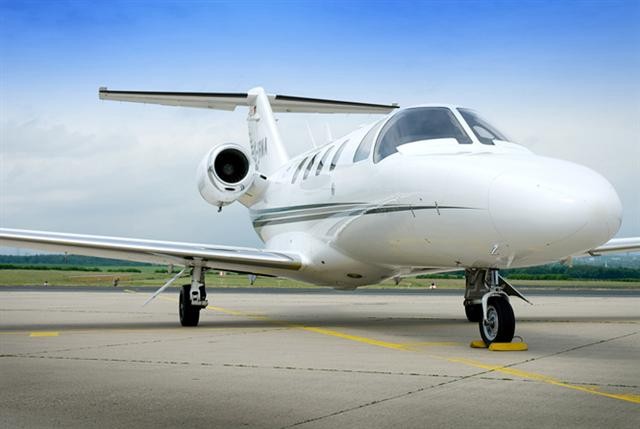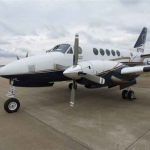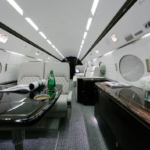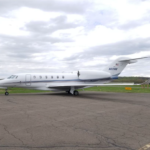by Tom Coogan
In the 1980’s the Cessna Citation 500 series was often burdened with the moniker, “Slotation”. In response Cessna developed a mostly clean sheet new design jet, named it the CitationJet and the 525 “CJ” series was born. One could argue that dubbing the new design as CitationJet when trying to differentiate itself from without impugning the Citation series is like naming your first son Patrick after his popular but aging older sister Patricia. No matter what the neighbors say, Patrick is no Patricia. CJ was designed with the speed conscience but economically motivated single pilot operator in mind. Initial deliveries in 1993 brought in a new age of light jets. Later variants (CJ2, CJ3 and CJ4) are each larger and more powerful than the predecessor.
A new wing using laminar flow aerodynamics mounted below instead of through the fuselage produces less drag while maintaining predictable and benign handling qualities keeping the owner/ single pilot safe. The wing uses bleed air de-icing on the leading edge. The 500 series cruciform tail was replaced with a T-tail keeping the airfoil and flight control in undisturbed air even at high angles of attack.
The CJ 525 family grew into the CJ1 and longer more powerful CJ2 (525A) around the turn of the century. The CJ2 carries an extra row of seating to total 10 including the pilot. These models carried a new avionics panel, the Collins Pro Line 21 series with a 2 or 3 screen EFIS. 2004 brought the CJ3 (525B) which is a longer version of the CJ2 with a more powerful FADEC engine. ln 2006 Cessna added a “+” to the CJ1 and CJ2 names with the Williams addition of FADEC and a few other updates to new production aircraft. The FJ-44-1AP replaced the FJ44-1 in the CJ1+ and a derated version of the CJ3 engine, the FJ44-3A-24 replaced the FJ44-2 in the CJ2+. These upgrades bring simpler operation and improved performance to a proven airframe. The Plus designation for the CJ3 came in 2014 and is a subject for another article. The CJ4 (525C) was on the ramp in 2010 and like many youngest siblings, is a bit of a rebel and a rule breaker. It carries new larger wings with leading edge sweep borrowed from its cousin the Sovereign. It has a redesigned heated glass windshield with increased sweep.
Let’s talk about the engines. Cessna went just a step or two out on a limb when adopting Williams as their engine manufacturer with the FJ-44 series. This simpler alternative to Cessna’s 500 and 550 series Pratt and Whitney powerplants has been a crowd pleaser for CJ operators. Each larger version of the CJ came with a more powerful version of the Williams FJ-44, starting with the 1900 thrust lb -1a on the CJ and CJ1 To the 3600 thrust lb -4a on the CJ4.
Worth mentioning is the Citation 510 Mustang which was developed and brought to market to compete with a seemingly growing, but in retrospect prone to attrition, stable of Very Light Jets. Another new product, the M2, basically a beautifully resurrected CJ1+ with an updated model of the same engine, Garmin 3000 avionics, a new interior and modern toys was made to bring competition to the Phenom 100 and the Honda Jet. We will dig into those another day. Let’s also leave the CJ4 for another day and take a look at the CJ1, CJ2, and CJ3 performance, operating cost and resale markets.
From Conklin and DeDecker:
| GENERAL COMPARISON | |||||||||||||||||||||
| Citation CJ1 | Citation CJ2 | Citation CJ3 | |||||||||||||||||||
| Cabin-Height (Ft.) | 4.75 | 4.75 | 4.75 | ||||||||||||||||||
| – Width | 4.83 | 4.83 | 4.83 | ||||||||||||||||||
| – Length | 11.00 | 13.58 | 15.67 | ||||||||||||||||||
| Cabin volume (Cu. Ft.) | 201.00 | 248.00 | 286.00 | ||||||||||||||||||
| Cabin Door Height (Ft.) | 4.25 | 4.25 | 4.25 | ||||||||||||||||||
| – Width | 2.00 | 2.00 | 2.00 | ||||||||||||||||||
| Baggage -Int. (Cu.Ft.) | 8.00 | 4.00 | |||||||||||||||||||
| – External | 51.00 | 70.00 | 65.00 | ||||||||||||||||||
| Typical Crew/Pass Seating | 2/5 | 2/6 | 2/6 | ||||||||||||||||||
| Weight-Max Take-off (Lbs.) | 10,600 | 12,375 | 13,870 | ||||||||||||||||||
| – Maximum Landing | 9,800 | 11,500 | 12,750 | ||||||||||||||||||
| – Basic Operating | 7,050 | 7,900 | 8,585 | ||||||||||||||||||
| – Usable Fuel | 3,220 | 3,932 | 4,710 | ||||||||||||||||||
| Payload-Full Fuel (Lbs.) | 430 | 668 | 775 | ||||||||||||||||||
| – Maximum | 1,350 | 1,400 | 1,925 | ||||||||||||||||||
| Certified | Yes | Yes | Yes | ||||||||||||||||||
| IFR Certified | Yes | Yes | Yes | ||||||||||||||||||
| Price – New (Corporate)/1000 | 4,145 | 5,716 | 8,347 | ||||||||||||||||||
| – Pre Owned Rng/1000 | 1,400/1,900 | 2,400/2,900 | 4,000/7,100 | ||||||||||||||||||
| – Years Produced | 2000 – 2005 | 2000 – 2006 | 2004 – 2013 | ||||||||||||||||||
| PERFORMANCE COMPARISON | |||||||||||||||||||||
| Citation CJ1 | Citation CJ2 | Citation CJ3 | |||||||||||||||||||
| Range-NBAA IFR Res (N.Mi.) | |||||||||||||||||||||
| Seats Full | 775 | 1,075 | 1,374 | ||||||||||||||||||
| Ferry Range – (Pilot(s) only, no pax) | 1,161 | 1,530 | 1,891 | ||||||||||||||||||
| Range-30 Min. Res (N.Mi.) | |||||||||||||||||||||
| Seats Full | |||||||||||||||||||||
| Ferry Range – (Pilot(s) only, no pax) | |||||||||||||||||||||
| Balanced Field Length (Ft.) | 4,220 | 3,820 | 3,440 | ||||||||||||||||||
| Landing Field Length – FAR 91 | 2,644 | 2,777 | 2,522 | ||||||||||||||||||
| Landing Field Length – FAR 135 | 3,305 | 3,471 | 3,152 | ||||||||||||||||||
| Landing Field Length – FAR 121 | 4,407 | 4,628 | 4,203 | ||||||||||||||||||
| Rate Of Climb (Ft/Min) | 3,230 | 3,870 | 4,478 | ||||||||||||||||||
| – One Engine Out | 850 | 1,160 | 1,090 | ||||||||||||||||||
| Cruise Speed-Max (KTAS) | 381 | 413 | 417 | ||||||||||||||||||
| – Normal | 381 | 413 | 417 | ||||||||||||||||||
| – Long Range | 307 | 344 | 348 | ||||||||||||||||||
| Stall Speed (IAS) | 77 | 82 | 82 | ||||||||||||||||||
| Ceiling-Certified MTOW (Ft.) | 41,000 | 45,000 | 45,000 | ||||||||||||||||||
| – Service | 41,000 | 45,000 | 45,000 | ||||||||||||||||||
| – Service OEI | 21,200 | 21,500 | 26,250 | ||||||||||||||||||
| ESTIMATED VARIABLE COSTS – Per Hour | ||||||||||||||||||||
| Citation CJ1 | Citation CJ2 | Citation CJ3 | ||||||||||||||||||
| Fuel (1) | $469.00 | $493.50 | $602.00 | |||||||||||||||||
| Fuel Additives | ||||||||||||||||||||
| Lubricants | ||||||||||||||||||||
| Maintenance Labor (2) | 108.30 | 111.15 | 109.25 | |||||||||||||||||
| Parts Airframe/Eng/Avion (3) | 111.69 | 122.54 | 99.78 | |||||||||||||||||
| Engine Restoration (4) | 241.92 | 266.24 | 278.16 | |||||||||||||||||
| Misc Exp. – Landing/Parking | 12.12 | 14.15 | 15.86 | |||||||||||||||||
| – Crew Expenses | 71.36 | 71.36 | 71.36 | |||||||||||||||||
| – Supplies/Catering | 33.96 | 33.96 | 33.96 | |||||||||||||||||
| Total Variable Cost/Hour | $1,048.35 | $1,112.90 | $1,210.37 | |||||||||||||||||
| Cost per Nautical Mile | $3.16 | $3.08 | $3.16 | |||||||||||||||||
| Average Speed-Kts. (6) 600-nm trip | 332.00 | 361.00 | 383.00 | |||||||||||||||||
| Cost data in this report is intended to be used as a benchmark | ||||||||||||||||||||
| Type of Operation: | Corporate | Corporate | Corporate | |||||||||||||||||
| 1. Fuel Cost | 3.50 | 3.50 | 3.50 | |||||||||||||||||
| Gallons/Hour Blk Fuel/Flt Time +15% | 134 | 141 | 172 | |||||||||||||||||
| 2. Maint. Labor Cost per Hour | 95 | 95 | 95 | |||||||||||||||||
| Maint. Hours/Flight Hours | 1.14 | 1.17 | 1.15 | |||||||||||||||||
| 3. Incl. Engine Parts Cost | No | No | No | |||||||||||||||||
| Engine Model | FJ44-1A | FJ44-2C | FJ44-3A | |||||||||||||||||
| Aircraft Model Year | 2005 | 2006 | 2013 | |||||||||||||||||
| 4. Overhaul Cost Source | TAP Elite14 | TAP Elite14 | TAP Elite14 | |||||||||||||||||
FJ44’s in up to and including the CJ3’s came with a 3500 hour TBO and a 1750 hour hot section inspection. Williams was able to get an extension to 5000 hour TBO’s and 2500 hour hot section inspections when certain parts are incorporated and the engine is enrolled in the Manufacturers Engine Maintenance program, the “Total Assurance Program” or” TAP”. This extension was announced in late 2014. Certainly in a first run engine this would seem to be a “must have” engine plan. On an aircraft which has had recent engine overhauls and the aircraft operability after the next 3500 hours is questionable, the decision is more complicated. In comparative pricing of a CJ with first run engines not on an EMP, the market price is reduced in most buyers eyes by the full value of the TAP buy in. Buyers of higher time aircraft with recently overhauled engines are more likely to be content with the non program engines with a market price reduction of less than full buy in. These adjustments to aircraft market values exist in all personal and business jet models but the TAP only periodic inspection extension of the FJ44 strengthens the argument in the CJs. There are always a few buyers who prefer no engine plan and may use a different pricing model
The CJ Market
Let’s take a peek at where straight CJ’s through CJ3’s are trading across selected production years. Unless we say otherwise, we will assume the aircraft is on TAP Elite or Blue with RVSM and no ADSB . Straight CJ’s require a panel upgrade to get ADSB so for now budget 155K for a GTN 650/750 upgrade or wait a year or so and a far less expensive option is expected using the core of the existing system. In the CJ1 and CJ2, upgrading the Garmin 530’s to WAAS/LPV and swapping in a pair of Garmin GTX 330 transponders can get you legal and LPV approach capable for 30 grand, less expensive than most of its business jet cousins. The CJ3 is not included in the SB/STC described above so for now that upgrade is around 75 to 80K through the GPS 4000s upgrade and could be more depending on specifics to the panel. If you decide to upgrade to the Pro Line Fusion with synthetic vision and all the toys expect to cough up around 300k.
In the following analysis JetNet, VRef, Controller and proprietary market information have been used to come up with values.
Straight CJ’s can be purchased for under 1m, sometimes well under 1m. Of the 349 in the fleet around 11 percent are for sale in the open market, just over the industry average of 10 percent. While the average time on market is 500 days on JetNet, the last 3 sales were on market for an average of 165 days.
Jump to a 2002 CJ1 and expect to pay 1.35m for an aircraft with around 4200 hours, which for a TAP example would put it just past or approaching its first overhaul depending on when it had the hot section done and whether it has the newer parts installed. Around 13 percent of the CJ1 fleet is for sale and average time to sell is 278 days, and again most recent sales were on the market for slightly less than that.
Let’s stay in the 2002 year group and look at the CJ2 market. More room, more seats, more power, more range. These attributes will cost you almost a million more than the same year group CJ1. Expect to pay 2.3m for the 4200 Hour 2002 CJ2. The CJ2 market is a little more robust with just under 9 percent of the fleet for sale and less than 200 days to sell on average.
In 2004 Cessna produced the CJ1, CJ2 and CJ3. Let’s compare how the market treats them.
A 2004 CJ1 with 3700 hours should fetch 1.55m. The CJ2 commands an 850k premium at 2.4m, and a 2004 CJ3 an additional million over at 3.4m.
The last year we will look at is 2008. In this year all 3 models have FADEC. In the 2004 example only the CJ3 had it. The 2008 CJ1+ is likely to cost 2.4m with 2400 hours, around 850K more than the non plus 2004 version. A 2008 CJ2+ with the same hours would be 3.45m, a 1.05M premium to the CJ1+. Remember the 2004 model CJ2 has a market value 800k higher than the CJ1. Another way to look at this is to say the 2004 CJ2 market value is fifty percent higher than the CJ1 and in the 2008 models just slightly less at 47 percent higher. When accounting for error allowance, one could consider the percent differentials identical. Finally the 2008 CJ3, around 4.25m, only 800k or 23 percent more than the CJ2+ from the same year.
Demand for personal and business jets in general was reduced by the shock and fear of asset depreciation following the 2008 to 2010 period when values plummeted. While large cabin values continue to slope downwards the CJ series has leveled out to a more historically standard depreciation rate. Steady prices bring a higher confidence that the CJ asset one is purchasing will hold its value to those buyers who had stayed out of the market fearing rapid asset depreciation.
The CJ series covers a broad range of needs over its different model designations in an economical, reliable single pilot operation. Cessna got this one right and sales figures show it.






